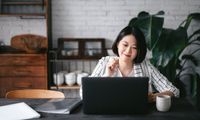Explore web search results related to this domain and discover relevant information.
The stock market consists of exchanges and over-the-counter markets where financial securities are traded.
The stock market plays a crucial role in modern economies by enabling money to move between investors and companies. People purchase stocks for a lot of reasons. Some hold onto shares, looking for income from dividends. Others look for low-priced stocks that are likely to gain value, so that they can sell at a profit. Still, others might be interested in having a say in how particular companies are run.Sometimes the best way to see how something works is to look at its parts. In that light, let's review the major elements of the stock market, from the companies selling shares to stocks to exchanges to the indexes that give us a snapshot of the stock market's health:Once a company goes public, its stock can be traded in the secondary market via exchanges or "over the counter." More than 58,000 companies worldwide are publicly traded today. When you buy a stock or a share, you're getting a piece of that company. How much of the company you own depends on the number of shares the company has issued and the number of shares you own.Funds: These include mutual funds, which pool money from many investors for a basket of stocks, bonds, and other securities, and exchange-traded funds, which trade on stock exchanges like individual stocks and "track" or try to mirror how a sector, index, or theme of stocks is doing. Preferred stocks: These stocks generally provide a set dividend and, as the name suggests, have priority over common stock in getting a share of the profits or what's left over if the company goes bankrupt. Real estate investment trusts (REITs): These are worth mentioning to get an idea of the breadth of what counts as the stock market.
:max_bytes(150000):strip_icc()/stockmarket.asp-d2f34bb1e91444069bc6e9b24cfdf6e8.jpg)

Using market multiples in business valuation is useful in determining a company's worth.
Market or valuation multiples relate a company’s value to a specific financial metric, such as EBITDA or revenue. These multiples are derived from the sale of comparable companies or the trading multiples of guideline public companies, typically within the same industry or sector.Enterprise Value-to-EBITDA (EV/EBITDA) Ratio: This multiple compares a company’s enterprise value to its earnings before interest, taxes, depreciation, and amortization (EBITDA). This is the most widely-used market multiple because the subject company’s profitability is already taken into account in the EBITDA to which the multiple is applied (unlike revenue multiples).When valuing a business, there are various methods and approaches analysts utilize to determine its worth. One popular approach is the application of market multiples under the market approach.Market multiples are valuation ratios derived from comparable company data in the market, which provides a benchmark for valuing a business based on its financial performance.

Twenty-four/seven trading markets enable investors to buy and sell assets at any time of day or night, providing access to global opportunities and advantageous price swings that are often unavailable during traditional market hours. However, greater access to opportunities doesn't always mean ...
Twenty-four/seven trading markets enable investors to buy and sell assets at any time of day or night, providing access to global opportunities and advantageous price swings that are often unavailable during traditional market hours. However, greater access to opportunities doesn't always mean greater gains.In traditional markets like the New York Stock Exchange (NYSE) and Nasdaq, trading only occurs during regular business hours and never on a weekend. However, that's changing soon, too, as these exchanges strive to keep pace with global trading demands. The NYSE has announced plans to move to a 22/5 trading schedule later in 2025.What makes a 24/7 market worth considering? Flexibility and global reach are two of the biggest benefits, as traders can respond to news or price changes in real-time. However, just because the 24/7 market doesn't sleep, doesn't mean that traders don't need rest.Technical analysis is a strategy used by traders to determine when to enter or exit the market based on statistical trends in trading activity, such as price movement and volume. This type of analysis uses price charts, trade volumes, and trends to forecast how a stock will behave in the future based on past performance.
Stock market data coverage from CNN. View US markets, world markets, after hours trading, quotes, and other important stock market activity.
Up-to-date stock market data coverage from CNN.Get the latest updates on US markets, world markets, stock quotes, crypto, commodities and currencies.


The NYSE’s unique market model combines leading technology with human judgment to prioritize price discovery and stability over speed for our listed companies.
The NYSE’s unique market model combines leading technology with human judgment to prioritize price discovery and stability over speed for our listed companies. Coupled with our electronic markets, we believe nothing can take the place of human insight and accountability.The cornerstone of the NYSE market model is the Designated Market Maker (DMM). DMMs have obligations to maintain fair and orderly markets for their assigned securities. They operate both manually and electronically to facilitate price discovery during market opens, closes and during periods of trading imbalances or instability.DMMs apply their market experience and judgment of dynamic trading conditions, macroeconomic news and industry-specific intelligence, to inform their decisions.A valuable resource for our listed-company community, DMMs offer insights, while making capital commitments, maintaining market integrity, and supporting price discovery.
I have written thousands of words on marketing your game. You can find all of my blog posts on this page. But if that feels like you jumping into the deep end, start here with my favorite starter posts. ... I write a TON about how to market your game but it can be a bit…
To really understand my voice, how passionate I am, and how fun this can be, watch my various talks and podcast appearances. ... Nobody has all the answers. We are all learning together. So, join my community where you can talk to me and other folks who are all going through the same stuff to try and get our games made and played. Check out my Discord and Follow me on twitter · I have been so fortunate to have the opportunity to help some big studios find their marketing voice.I provide comprehensive courses to teach you how the pros do it. ... If you have a very specific need for your marketing or you would like to have some more personalized mentoring, I do offer 1-on-1 consulting services.I am a game marketing consultant and strategist. I have helped Games-as-a-Service companies, indie publishers, and small to single-person teams understand their audience and communicate with them in a more personal way.I also love teaching people and think everyone should have a shot at making games. I want to help studios who are confused, frustrated, or just totally ambivalent to the process of marketing their wonderful games.

This isn’t the first time the investment factor has thrived in turbulent periods.
My colleague John Rekenthaler has even used Berkshire as a totem of the risk-off market, where investors are fleeing to assets perceived as relatively safe. Johnson & Johnson JNJ and Coca-Cola KO are other low-volatility index constituents that have held up relatively well this year. Source: Morningstar Direct. Index constituent data as of March 31, 2025 and year to date return data through April 21, 2025. How did these constituents get selected?Plus, how factor investors can position their portfolios for future stock rotations. ... Low volatility isn’t the only factor that has gone from zero to hero in 2025, at least in relative terms. Value, yield, and size have all lost less than the market so far in 2025 after having lagged in 2023 and 2024.There’s also nothing wrong with avoiding factors altogether and just owning the broad equity market. That strategy has been a winner in recent years. More-muted returns and trickier conditions, however, could lead to a revival in factor investing.How we use your information depends on the product and service that you use and your relationship with us. We may use it to: Verify your identity, personalize the content you receive, or create and administer your account. Provide specific products and services to you, such as portfolio management or data aggregation. Develop and improve features of our offerings. Gear advertisements and other marketing efforts towards your interests.
Learn how to conduct a market analysis with this step-by-step guide. Discover key insights, research techniques, and strategies to understand your market.
By mastering market analysis, you’ll gain a clear picture of your audience, spot emerging trends, and assess your competitors with precision. This isn’t about predictions—it’s about using data to make strategic, informed decisions that give you a real competitive advantage. ... Before we discuss how to conduct a market analysis, let’s define it clearly.When demand exceeds supply, there’s potential for new products or market entrants. Conversely, when there’s oversupply, competition ramps up, and standing out becomes critical. ... Next, you need to understand who your customers are and how they make buying decisions.Market analysis isn’t just a “nice-to-have”—it’s the foundation for making decisions that grow businesses and avoid costly mistakes. · Here’s how market analysis comes into play in four critical scenarios you are bound to face:Behavior: How do they engage with products like yours? (buying habits, preferred channels, decision triggers) Here are some of the methods you can use to gather target customer insights: ... The more specific your personas, the more effective your strategy will be. To establish your own niche in the market, you need to understand the strengths and weaknesses of the existing players.

Standard approaches to the theory of financial markets are based on equilibrium and efficiency. Here we develop an alternative based on concepts an...
However, this happens slowly and the evolution is so noisy that there are large fluctuations away from the efficient state, causing bursts of volatility and extended periods where prices deviate from fundamental values. This provides a conceptual framework that gives insight into the reasons why markets malfunction.In the absence of noise, the market would slowly evolve toward an efficient equilibrium, but the statistical uncertainty in profitability (which is calibrated to match real markets) makes this noisy and uncertain. Even in the long term, the market spends extended periods of time away from perfect efficiency. We show how core concepts from ecology, such as the community matrix and food webs, give insight into market behavior.For example, at the efficient equilibrium, all three strategies have a mutualistic relationship, meaning that an increase in the wealth of one increases the returns of the others. The wealth dynamics of the market ecosystem explain how market inefficiencies spontaneously occur and gives insight into the origins of excess price volatility and deviations of prices from fundamental values.Large price movements occur even when there is very little new information (1), and prices often deviate substantially from fundamental values (2). This means that we need to go beyond the theory of market efficiency to understand how and why markets malfunction.


Traditional market hours are restricted to 9:30 a.m. to 4 p.m. But 24/7 trading offers the ability to trade securities and assets at almost any time.
To execute 24/7 trading, investors must use special trading platforms. Most U.S. equities still trade during the standard trading hours, but even the major markets like the NYSE and Nasdaq are expanding with pre-market and after-hours trading and exploring 24/7 trading in the future.Platforms like Blue Ocean Alternative Trading System (BOATS) allow investors to trade select U.S. equities on brokerage platforms like Charles Schwab, Clear Street, Webull, and Interactive Brokers (IBKR) after traditional trading hours. When many investors and market makers log out for the day, savvy investors use these platforms to seize opportunities to react to global news, earnings reports, and market-moving events by logging on.Forex (foreign exchange) trading is also traded nearly 24/7. Forex markets are open 24 hours a day, but five days a week (excluding weekends) across four major financial centers like London, Sydney, New York, and Tokyo.U.S. equity securities and traditional exchange-traded funds (ETFs) are becoming increasingly available after hours as long as the asset has enough supply and demand to support trading. Webull, Interactive Brokers, and E-Trade facilitate pre-market trading as early as 4:00 a.m.

Here's the chance to position yourself as a subject matter expert and showcase your expertise.
When you attend social events, you can expect certain questions to come in your direction. Since people know you are a financial advisor (or learn pretty quickly), they often ask, “How’s the market?” You don’t know their level of interest, but you need to give an answer.© Touchpoint Markets, All Rights Reserved. Request academic re-use from www.copyright.com. All other uses, submit a request to [email protected]. For more inforrmation visit Asset & Logo Licensing. ... Learn how a fixed indexed annuity (FIA) may be just what clients are missing.How to Enhance & Protect Portfolios with NDX� and XND� Index Options Download Now ›
To make a market is to display a bid (where you are willing to buy) and an ask or offer (where you are willing to sell). If you were a grocer, for instance, and were asked to make a market on the price of an apple, you might indicate $0.10 - $0.50 ("ten cents bid at fifty cents").
He currently researches and teaches economic sociology and the social studies of finance at the University of Lucerne in Switzerland.Adam's new book, "Irrational Together: The Social Forces That Invisibly Shape Our Economic Behavior" (University of Chicago Press) is a must-read at the intersection of behavioral economics and sociology that reshapes how we think about the social underpinnings of our financial choices. ... Making a market is an action whereby a dealer or market maker stands by, ready to make a two-sided quote.Market makers profit through the market-maker spread, not from whether a security goes up or down. They are supposed to buy or sell securities according to what kind of trades are being placed, not according to whether they think prices will go up or down. ... The offers that appear in this table are from partnerships from which Investopedia receives compensation. This compensation may impact how and where listings appear.To make a market is to display a bid (where you are willing to buy) and an ask or offer (where you are willing to sell). If you were a grocer, for instance, and were asked to make a market on the price of an apple, you might indicate $0.10 - $0.50 ("ten cents bid at fifty cents").This means you'd be willing to buy an apple for a dime, and sell an apple for half a dollar. The key point is that when asked to make a market, you do not necessarily know in advance if the requester is an interested buyer or seller.
:max_bytes(150000):strip_icc()/GettyImages-815186572-8f25001a21cc4458a9c5d00112b66f18.jpg)

The stock market refers to public markets that exist for issuing, buying and selling stocks that trade on a stock exchange or over-the-counter.
There are a number of regular participants in stock market trading. Investment banks handle the initial public offering (IPO) of stock that occurs when a company first decides to become a publicly traded company by offering stock shares. Here’s an example of how an IPO works.The overall performance of the stock market is usually tracked and reflected in the performance of various stock market indexes. Stock indexes are composed of a selection of stocks that is designed to reflect how stocks are performing overall.Publicly traded companies are required by exchange regulatory bodies to regularly provide earnings reports. The reports, issued quarterly and annually, are carefully watched by market analysts as a good indicator of how well a company’s business is doing.The secondary purpose the stock market serves is to give investors – those who purchase stocks – the opportunity to share in the profits of publicly traded companies. Investors can profit from stock buying in one of two ways.

In the business world, knowing your target market is crucial to success. Any time you introduce a new product or service, how do you know anyone is going to buy it? Learn all about market research.
Do people need the product or service you are offering? If so, how many people need it? Which features are important to these people and which are not? What price would customers be willing to pay, and why? The process that you use to get answers to questions like these is called market research.In this article, you will have the opportunity to learn about the market research process from both a business perspective and a consumer perspective. ... Let's go back to the first situation we examined at the beginning of this article. You are currently working as an employee, and you have an idea for a new product or service. The product could be anything -- a new way to package ketchup in a grocery store, or dry granules that you can use to "wash" your car without water, or a very cute stuffed animal. How do you find out if anyone wants or needs your ketchup package, your car granules or your stuffed animals?The fact that there is a competing product tells you that there are some customers out there, and you can access your competitor's market research by looking at the products your competitor is producing. Assuming, that is, that the competitor did any market research. ... Who, if anyone, has a real need for the thing I propose to sell, and how many of those potential customers are there?By using the Internet, either in the form of e-mail surveys or online questionnaires, the cost of market research goes down. E-mail surveys now have the problem that they look and feel like spam, and are often eliminated by spam filters. That leaves online surveys as a great way to reach lots of customers. The other advantage of Internet surveys is that they can be very fast. You can post a survey and get preliminary answers within 24 hours. The survey system now available on HowStuffWorks is typical of this form of market research.
Virtual trading stock market games are the best way to test and practice trading. Have fun learning to trade with our virtual stock market game.
COLLEGE PROFESSORS: Learn more about our college stock market game. ... Finding great resources for economics and personal finance classes can be tough – which is why we are here to help! HowTheMarketWorks is the only free stock game designed for the classroom.
Free stock market game with real-time trading. Create a custom stock game for your class, club, or friends and learn to invest.We offer a free stock market game featuring real-time stock prices and rankings that allows users to learn about the stock markets and practice investing in stocks, ETFs, bonds, and mutual funds.To get your class started with our free stock market game, just register now and then follow the links to create your own contest.

Several industries might be competing to serve the same market you’re targeting. Important factors to consider include level of competition, threat of new competitors or services, and the effect of suppliers and customers on price.
Market research helps you find customers for your business. Competitive analysis helps you make your business unique.Market research blends consumer behavior and economic trends to confirm and improve your business idea.It’s crucial to understand your consumer base from the outset. Market research lets you reduce risks even while your business is still just a gleam in your eye.You can do market research using existing sources, or you can do the research yourself and go direct to consumers.


Stocks are shares of ownership in a public company, and the stock market is where investors connect to buy and sell investments like stocks.
And while our site doesn’t feature every company or financial product available on the market, we’re proud that the guidance we offer, the information we provide and the tools we create are objective, independent, straightforward — and free. So how do we make money?The stock market is where investors connect to buy and sell investments — most commonly, stocks, which are shares of ownership in a public company. Many, or all, of the products featured on this page are from our advertising partners who compensate us when you take certain actions on our website or click to take an action on their website. However, this does not influence our evaluations.Conversely, investing in the stock market for the long term has proven to be an excellent way to build wealth over time. For example, the S&P 500 has a historical average annualized total return of about 10% before adjusting for inflation. However, the market will rarely provide that return on a year-to-year basis.Supply and demand help determine the price for each security, or the levels at which stock market participants — investors and traders — are willing to buy or sell. This process is called price discovery, and it’s fundamental to how the market works.

Learn how the stock market works, why companies issue stock, what happens when you buy a stock, and what happens when you sell a stock.
He currently researches and teaches economic sociology and the social studies of finance at the University of Lucerne in Switzerland.Adam's new book, "Irrational Together: The Social Forces That Invisibly Shape Our Economic Behavior" (University of Chicago Press) is a must-read at the intersection of behavioral economics and sociology that reshapes how we think about the social underpinnings of our financial choices. ... A stock market is a place where companies raise capital by selling shares of stock (also known as 'equity') to investors.Stock exchanges date back to the 17th century, with the Amsterdam Stock Exchange, established in 1602, often cited as the world's first formal stock market. However, the concept of trading company shares existed even earlier, with the Roman Republic having a system for trading shares in publicani companies.Major stock market indexes include the Dow Jones Industrial Average (DJIA) and the S&P 500. The DJIA is a price-weighted index of 30 large American corporations. Because of its weighting scheme and the fact that it only consists of 30 stocks (when there are many thousands to choose from), it is not necessarily the best indicator of how the stock market is doing.To take a more active role in the stock market, you can also choose to hold specific stocks, ETFs, or mutual funds. Understanding how to invest in the stock market can help you make more informed decisions, maximize returns, and manage risks effectively.
How Market Design Emerged from Game Theory: A Mutual Interview by Alvin E. Roth and Robert B. Wilson. Published in volume 33, issue 3, pages 118-43 of Journal of Economic Perspectives, Summer 2019, Abstract: We interview each other about how game theory and mechanism design evolved into practical ...
How Market Design Emerged from Game Theory: A Mutual Interview by Alvin E. Roth and Robert B. Wilson. Published in volume 33, issue 3, pages 118-43 of Journal of Economic Perspectives, Summer 2019, Abstract: We interview each other about how game theory and mechanism design evolved into practical ma...When we learned game theory, games were modeled either in terms of the strategies available to the players ("noncooperative games") or the outcomes attainable by coalitions ("cooperative games"), and these were viewed as models for different kinds of games. The model itself was viewed as a mathematical object that could be examined in its entirety. Market design, however, has come to view these models as complementary approaches for examining different ways marketplaces operate within their economic environment.Mathematical models themselves play a less heroic, stand-alone role in market design than in the theoretical mechanism design literature. Other kinds of investigation, communication, and persuasion are important in crafting a workable design and helping it to be adopted, implemented, maintained, and adapted. Roth, Alvin E., and Robert B. Wilson. 2019. "How Market Design Emerged from Game Theory: A Mutual Interview."(Summer 2019) - We interview each other about how game theory and mechanism design evolved into practical market design. When we learned game theory, games were modeled either in terms of the strategies available to the players ("noncooperative games") or the outcomes attainable by coalitions ("cooperative games"), and these were viewed as models for different kinds of games.
:max_bytes(150000):strip_icc()/stockmarket.asp-d2f34bb1e91444069bc6e9b24cfdf6e8.jpg)



:max_bytes(150000):strip_icc()/GettyImages-815186572-8f25001a21cc4458a9c5d00112b66f18.jpg)

